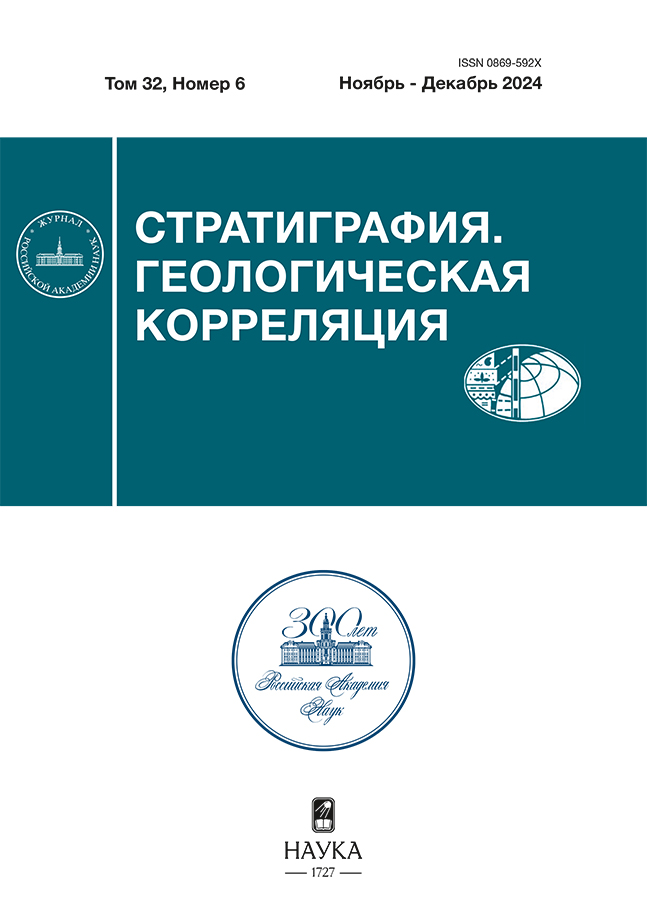卷 32, 编号 6 (2024)
Middle Ordovician of the Gorny Altai: litho-biostratigraphy and justification of regional units boundaries
摘要
New paleontological and biostratigraphic data were obtained for the five sections, and previously known materials were updated for the three sections of the Middle Ordovician of the Charysh-Inya and Uymen’-Lebed’ facies zones of the Gorny Altai. Regional stratigraphic stages namely Kuibyshevo and Kostinsky horizons are discussed in details. By graptolites the complete stratigraphic volume of the Kuibyshevo regional unit is defined as following zonal succession: (1) sinodentatus/Cardiograptus/Oncograptus, sinodentatus, (2) austrodentatus, (3) dentatus; as well as the Kostinsky regional unit within the lentus/balhaschensis/kirgisicus Zone. For the Kostinsky Horizon, Beds with conodonts Eoplacognathus pseudoplanus were defined in the Batun Section, and in the Baraniy-1 Section, the same age Beds with conodonts Semiacontiodus asymmetricus– Parapanderodus striatus were defined. For the first time in the stratotype of the Kuibyshevo Horizon (Maralikha Section), from the Voskresenka Formation, a benthic fauna assemblage represented by brachiopods was found and identified.
 3-29
3-29


Volgian stage of the Upper Jurassic and Ryazanian Stage of the Lower Cretaceous of the Panboreal biogeographic Superrealm
摘要
The history of the study of the Volgian Stage of the Upper Jurassic and Ryazanian Stage of the Lower Cretaceous, their geographical distribution and use in the world practice, subdivision and correlation are considered. The data on the distribution of different groups of macro- and microfossils (ammonites, bivalves, radiolarians, dinocysts, and marine reptiles) in the Volgian and Ryazanian stages are reviewed. In all these groups, despite significant differences in lifestyle, the Volgian and Ryazanian assemblages, on the one hand, show a high degree of similarity throughout the Panboreal Superrealm, and on the other hand, significant differences from the coeval Tethyan faunas. Biostratigraphic scales of this age based on the sequences of ammonites, bivalves, radiolarians and dinocysts are analysed. It is shown that the substage boundaries of the Volgian Stage are reliably traceable throughout the Panboreal Superrealm. At the same time, no boundary other than the Volgian Stage base corresponds even to the zonal boundary in the Tethys-Pantalassa Superrealm. A similar situation is observed in the Ryazanian Stage: its lower boundary, as well as the boundary of the Lower and Upper Ryazanian substages do not coincide with any clear boundary in the Tethys-Pantalassa Superrealm. The necessity of using the Volgian and Ryazanian stages in the practice of geological research on the territory of Russia for all regions where Boreal deposits are distributed, as well as the inclusion of these stages in the General Stratigraphic Scale in parallel with the Tithonian and Berriasian is substantiated. It is proposed to cancel the resolution of the ISC of Russia on the considering the Volgian Stage to the rank of regional stratigraphic subdivisions, as well as to revise the scheme of comparison of the Volgian and Tithonian stages adopted in the same document.
 30-73
30-73


Taxonomic composition of the Hauterivian bryozoan assemblage in the environs of Gunib village (Dagestan)
摘要
The Lower Cretaceous bryozoan assemblage in the environs of Gunib village in Dagestan is for the first time described. The studied section is located in the zone of development of the Gapshima Formation (Hauterivian) deposits. The bryozoan assemblage is characterized by high taxonomic diversity and includes 32 taxa from four suborders of order Cyclostomata: Tubuliporina (24 taxa), Cancellata (1 taxon), Articulina (1 taxon) и Cerioporina (6 taxa). Due to the poor preservation of the colonies, most taxa are defined in open nomenclature; therefore, the true diversity of cyclostomes in the study area is not fully reflected. The assemblage includes the taxa that have the similarities to bryozoans previously described from different levels from Valanginian to Barremian of Switzerland and France and, partly, from the lower Hauterivian of Germany (Mecynoecia icaunensis (d’Orbigny), Mesenteripora marginata (d’Orbigny), M. reticulata (d’Orbigny), Poriceata ardescensis Walter, Apsendesia neocomiensis d’Orbigny, Diplocava biformis (Roemer), “Heteropora” arborea Koch et Dunker, and Elea periallos Taylor). The main difference of the Gunib assemblage from the Valanginian–Hauterivian assemblage of Switzerland and France and the lower Hauterivian assemblage of Germany is in having bryozoans from the family of Eleidae, but it differs from the Barremian assemblage of France in lacking of representatives of Cheilostomata. Among the studied cyclostomes, bryozoans with erect colonies predominate, some of which were bilateral leaf-shaped, while others had thin cylindrical branches. Reticulate and massive colonies are rare, while encrusting bryozoans, which grow over erect colonies, are quite numerous.
 74-100
74-100


On the genesis of Quaternary deposits in the Yaloman-Katun zone of the Altai Mountains and the practicability of introducing the catafluvial genetic type
摘要
The paper discusses the research and methodological aspects of introducing the new term “catafluvial deposits” into genetic classification of Quaternary deposits. For this purpose, fieldwork was carried out aimed at studying terrace complexes within the Yaloman-Katun zone of Gorny Altai, which in recent decades became a peculiar natural laboratory for studying hypothetical glacial superfloods. Based on original materials and data from other areas with similar geological and physico-geographical conditions, it is concluded that the categorization of a separate genetic type “catafluvial” should currently be considered premature.
 101-130
101-130










